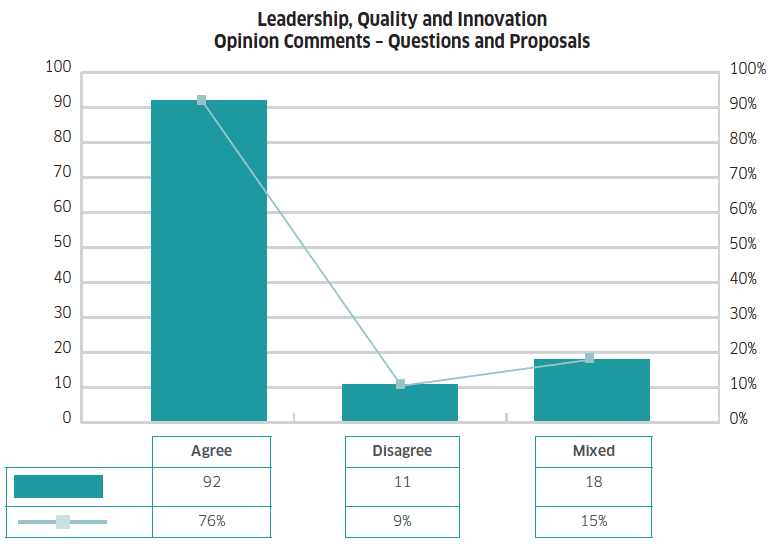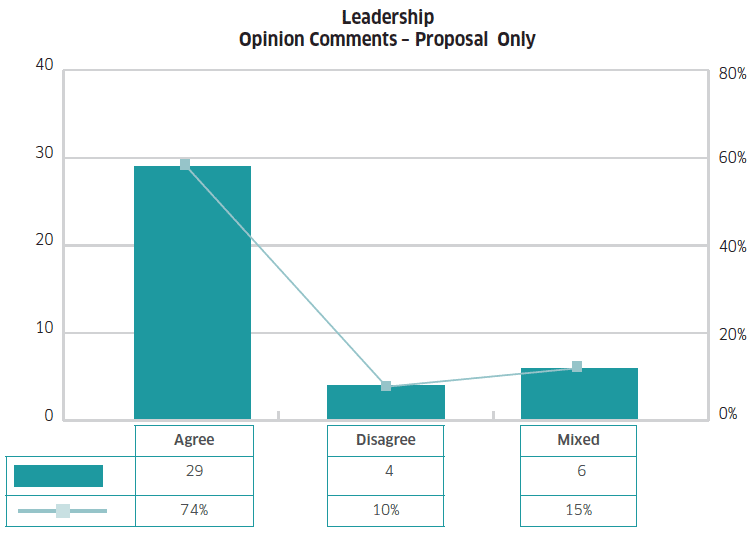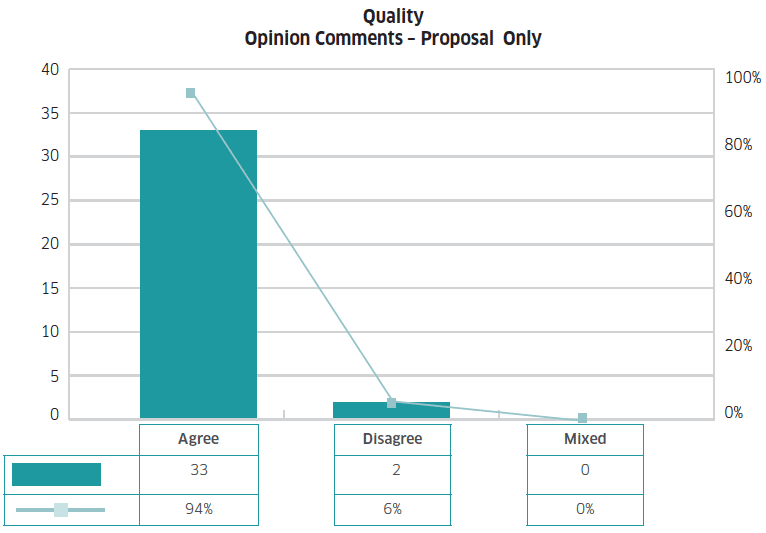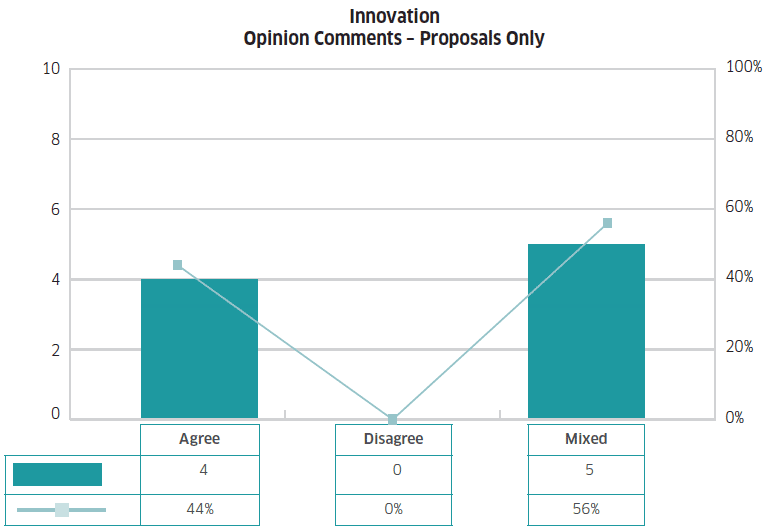Healthcare science national delivery plan consultation: analysis of responses
This report provides an analysis of responses to our consultation on proposals for a healthcare science national delivery plan.
2.0 Questions around Leadership, Quality and Innovation
How can HCS best influence the improvement of patient care, utilising the quality tools at their disposal?
Are the right systems in place across HCS delivery?
If not, what can be done to improve the adoption of quality systems and reduce variation in their use throughout the patient pathway continuum?
How might we strengthen HCS leadership at strategic and operational levels to support innovation and promote the added value that HCS can bring to current challenges and priorities?
Graph 5 shows the percentage and count of respondents' replies on Leadership, Quality and Innovation on either questions and/or proposals. Opinion statement replies have been categorised as Agree, Disagree and Mixed.

2.1 summary of what you told us around Leadership
A significant majority of health board and professional bodies' responses were supportive of Healthcare Science Leadership in each board and the requirement for HCS forums. There was some concern that one HCS professional lead per board would be insufficient in the larger boards, representing significant numbers of HCSs and different services, potentially this also requires to be a full-time position.
One Healthcare Science forum felt very strongly that a HCS Director is vital for the delivery of the NDP proposals in conjunction with a full-time HCS lead.
Graph 6 shows the percentage and count of respondents' replies on leadership proposals within the consultation document. Opinion statement replies have been categorised as Agree, Disagree and Mixed.

Significant responses highlighted "that in boards where there is no HCS Lead and/or forum there is real disconnect" between service providers and the board.
There were significant respondents that highlighted the potential for all of Healthcare Science to sit within a Healthcare Science Directorate; this centralised delivery would enhance the delivery of the national plan.
There was very much the requirement to be involved in board decisions, at an early stage when any service that requires a HCS contribution is being designed.
However, concerns were expressed that leadership development generally has been neglected within this workforce, more engagement between HCS and their stakeholders is required, in order for the HCS workforce to understand the challenges the NHS is facing.
Numerous respondents called for more engagement between HCS NDP and the work of the National Diagnostic Networks, there is potential that the "network steering groups and developing infrastructure can become key groups placed to identify and address major sources of waste, variation and harm in service delivery nationally".
Significant number of respondents highlighted the support for leadership around Health Technology Management, with the requirement for an integrated point-of-care-testing (POCT).
The Royal College of Pathology (RCPath) and Institute of Physics and Engineering in Medicine (IPEM) highlighted work with the Modernising Scientific Careers Team for Higher Specialist Scientific Training (HSST), in order to provide a structure of training for clinical scientists to prepare them for consultant positions, there is a strong dimension of leadership and quality within HSST.
There was one individual response that does not agree with the approach of HCS professional and improvement leads and makes an alternative suggestion, that these responsibilities should be of the "existing Heads of Healthcare Science Services", with one of the Head of Service acting as a spokesperson for HCS at NHS Board level. Also one 'group' response had mixed views about a HCS professional Lead and the local HCS forum model. It was suggested that one of the 'Heads of Service' could act as a spokesperson for HCS at NHS Board level and also the Heads of Service should be the forum. Feedback also stated lack of agreement with the title 'HCS Professional Lead'.
2.2 summary of what you told us around Quality
There was recognition from respondents from the Life Science theme that laboratories "are well served by the accreditation bodies". However concern was expressed with regards to the increasing demands to meet ISO 15189.
Many of the Clinical Physiology respondents did not feel that the right systems were in place around 'Leadership and Quality'.
Graph 7 shows the percentage and count of respondents' replies on quality proposals within the consultation document. Opinion statement replies have been categorised as Agree, Disagree and Mixed.

The Clinical Physiology and Physical Sciences noted that it is only the theme of Life Science that has the role of quality managers, but many responses from the Life Science stream highlighted the potential for laboratory quality managers to support other streams of HCS to develop their knowledge of Quality Management Systems.
There is a requirement for better data analysis, especially around 'Keele' benchmarking, and the potential for a Scottish national approach.
Service providers of Audiology, felt they are "in a strong position to influence the improvement of patient care", very much through the Audiology Quality Standards, but have concerns around continuing to meet the 18-week waiting list target.
One health board response indicated that Improving Quality in Physiological Services (IQUIPs) quality control process "is cumbersome, time consuming and costly for small departments" in that this voluntary Clinical Physiologist accreditation gives little direction in terms of quality and standards.
There was a theme coming out that the development of "embedded culture in quality" requires to take place, with more of an emphasis on quality improvement training. However there was concern that improvement methodology should not be dictated by the National Delivery Plan, and should be implemented by the health boards.
The Institute of Physics and Engineering in Medicine (IPEM), highlighted that healthcare professionals "are very pro-active in leading the development of appropriate Quality Management Systems for the services they deliver". Currently the Improving Clinical Engineering and Physical Science Services (iCEPSS) accreditation standard is under development.
2.3 summary of what you told us around Innovation
Overall, there were fewer responses to the questions asked around research and innovation. However, numerous transformational examples where citied.
There was strong support for the sharing of best practice, some Life Science disciplines have professional networks, but not all areas of service provision have a network.
Concerns were raised that resource and support from management for service innovation and development projects require to be addressed. Concern was noted in the quote "cutting costs by downward pressures on staffing, flattening of structures do not lead to the erosion of knowledge and skills required to deliver and support research and innovation".
One of the networks expressed that there should be 'national guidance' for NHS Boards and academic colleagues to engage with the HCS services.
One respondent group expressed that the action plan needs to address issues around the "interrelationship with academic institutions and commercial organisations".
Graph 8 shows the percentage and count of respondent's replies on innovation proposals within the consultation document. Opinion statement replies have been categorised as Agree, Disagree and Mixed.

Contact
Email: Julie Townsend
There is a problem
Thanks for your feedback